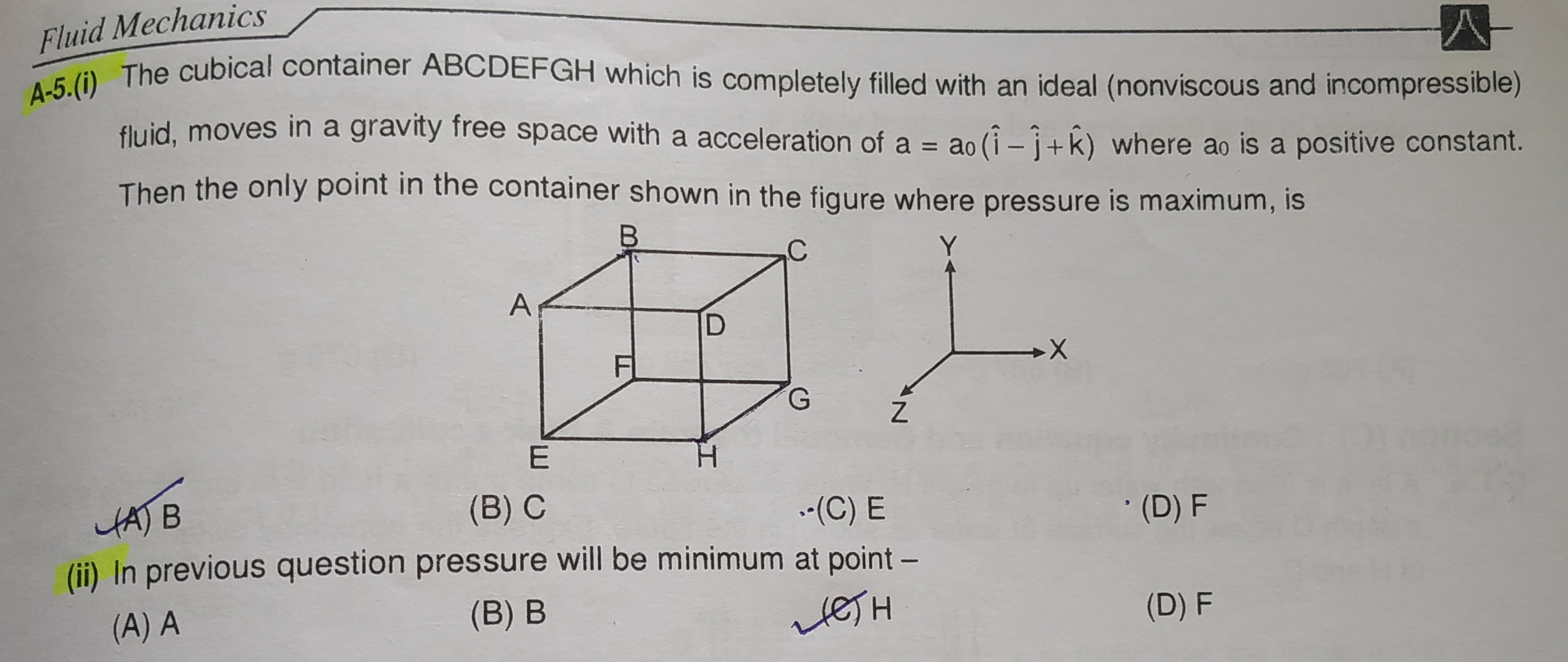Question
Question: A-5.(i) The cubical container ABCDEFGH which is completely filled with an ideal (nonviscous and inco...
A-5.(i) The cubical container ABCDEFGH which is completely filled with an ideal (nonviscous and incompressible) fluid, moves in a gravity free space with a acceleration of a = a0(i^−j^+k^) where a0 is a positive constant. Then the only point in the container shown in the figure where pressure is maximum, is
(ii) In previous question pressure will be minimum at point -

B
C
E
F
The maximum pressure is at point A, which is not listed in the options. Among the given options B and E have maximum pressure.
Solution
The pressure variation in a fluid accelerating with acceleration a in a gravity-free space is given by the equation:
∇P=−ρa
This equation indicates that the pressure increases in the direction opposite to the acceleration vector a. Conversely, the pressure decreases in the direction of the acceleration vector a.
The given acceleration is a=a0(i^−j^+k^), where a0 is a positive constant. So, the direction of acceleration is (1,−1,1).
To find the point of maximum pressure, we need to find the point that is farthest in the direction opposite to a. The direction opposite to a is −a=a0(−i^+j^−k^).
The pressure at any point r=(x,y,z) relative to a reference point (say, the origin E) can be written as:
P(r)=PE−ρa⋅r
To maximize P(r), we need to minimize the dot product a⋅r.
a⋅r=a0(i^−j^+k^)⋅(xi^+yj^+zk^)=a0(x−y+z).
So, we need to find the vertex (x,y,z) for which the value of (x−y+z) is minimum.
Let's define the coordinates of the vertices of the cube assuming E is at the origin (0,0,0) and the side length of the cube is L. Based on the provided diagram with X, Y, Z axes:
- E = (0, 0, 0)
- H = (L, 0, 0)
- F = (0, 0, L)
- G = (L, 0, L)
- A = (0, L, 0)
- D = (L, L, 0)
- B = (0, L, L)
- C = (L, L, L)
Now, let's calculate (x−y+z) for each vertex:
- For E (0,0,0): 0−0+0=0
- For H (L,0,0): L−0+0=L
- For F (0,0,L): 0−0+L=L
- For G (L,0,L): L−0+L=2L
- For A (0,L,0): 0−L+0=−L
- For D (L,L,0): L−L+0=0
- For B (0,L,L): 0−L+L=0
- For C (L,L,L): L−L+L=L
The minimum value of (x−y+z) is −L, which occurs at point A. Therefore, the pressure is maximum at point A.
For Part (ii): Minimum Pressure
To find the point of minimum pressure, we need to maximize the dot product a⋅r, which means maximizing (x−y+z).
The maximum value of (x−y+z) is 2L, which occurs at point G. Therefore, the pressure is minimum at point G.
